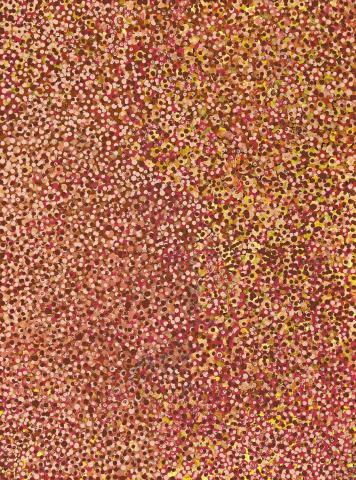OOROOTERNA, WILD FRUITS, 1991
Emily Kame Kngwarreye
synthetic polymer paint on canvas
121.0 x 91.0 cm
inscribed verso: artist's name, Delmore Gallery cat. 1Z107
Delmore Gallery, Alice Springs
Gallery Gondwana, Alice Springs
Private collection, New South Wales
The cycles of birth, death and endless renewal are made manifest in the seasonal feast and famine of traditional central desert life. With rain infrequent, Emily Kame Kngwarreye's memories of her childhood and early adult years spent travelling as the elements dictated were to form much of the framework for her artistic practice. This period was described by Jennifer Isaacs as ‘a time of seasonal movement, of harvesting wild seeds, fruits, vegetables, and animals on her own country'.1
Whilst the contrasts of Kngwarreye's country were never as harsh as those encountered on the Pintupi lands to the far west, it was still a period of celebration and abundance when the spring and summer rains fell. With a profusion of seed plants blossoming in concert, Oorooterna—Wild Fruits, 1991, is a tribute the riotous bounty of the central desert. Kngwarreye's knowledge and ability to find and identify an enormous range of wild desert food marked her as a figure of senior custodial importance.
Rendered in a glowing high key palette, Isaacs muses that‘in retracing through her mind's eye the country of her Dreaming… Emily was perhaps exploring her sense of delight during childhood when moving quickly among the grey solanum bushes picking tomatoes and raisins and eating them quickly.'2
In the certificate which accompanies this painting, Janet Holt draws upon her considerable knowledge of the artist's practice to note: 'The powerful utilisation of colours in this work have been taken from the “berry” called oorooterna. The berry's fruits range from the pale cream through a spectrum of yellows into oranges and finally into a red/orange. This progression is determined by the stage of ripeness or decay of the fruit.
The observations of the desert plants' lifecycles are intrinsic to survival and are part of the education reinforced through ceremony. As senior ritual woman for her country called Alalgura, it is Emily's social obligation to educate her nieces who have inherited the custodial responsibility for bush tucker species of this place. Ceremonially she “grows up” both the plant and human sources of her country. Socially, she influences her niece's development to help guarantee that her knowledge will be passed into future generations.'3
1. Isaacs, J., Emily Kngwarreye—Paintings, Craftsman House, Sydney, 1997, p. 13
2. Ibid. p. 14
3. Holt, J., certificate of authenticity from Gallery Gondwana, Alice Springs, 1992
MERRYN SCHRIEVER
